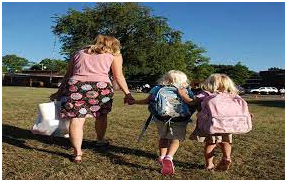
Many children are somewhat hesitant or reluctant to go to school. Parents have to listen to thousands of excuses when they are asked to go to school. Children typically don’t have any desire to be away from their parents. That’s normal. That is why parents do not give a lot of significance to this issue. Their expectation is that this problem will be solved naturally over time. And by and large this is the situation.
However, in the case of certain children, this transient thing takes a terrible shape. The fear that is supposed to decrease automatically with time, is increasing day by day. Day-to-day effects are also observed on the physical and emotional wellness of a child. In like manner speech this is called ‘school avoidance’, ‘school refusal’ or ‘school phobia’.
In medical parlance this is known as . According to psychologists, this type of fear is most normal in children between the ages of four and six, who are usually pre-school students. This fear is somewhat hard to recognize. Because so many little kids can’t communicate their thoughts well. What’s more, regardless of whether it is communicated, it is hard to comprehend whether the dread is typical or unusual. Didaskaleinophobia is also occasionally seen in 13-15-year-old high school students.
Symptoms of a child with didaskaleinophobia
Some physical and emotional changes are seen in a child with Didaskaleinophobia . E.g.
- Crying for not to go school, pretending to be sick, or hurting himself when parent talk about going to school.
- Phobic children often have negative thoughts, especially related to death. Thinking that something bad could happen to his/her family and parents can make his/her mind and brain numb. As a result, they do not want to leave them even for a moment.
- The problem with teenagers is that they have no desire to speak. That’s why they start avoiding everything. To lie is more intense in this case with going to school. Impressions are gained in a fluid, global, diffused way.
- Symptoms such as dizziness, palpitations, dry mouth, frequent sweating, shortness of breath, nausea, and panic attacks are some of the common physical changes in the case of Didaskaleinophobia .
Remedy
Moreover, there are some more matters. If the school environment is not safe or child-friendly, such as bullying, severe punishment for not being able to read, dangerous behavior of a person involved in the school or any such incident can lead to Didaskaleinophobia in the child. Again, if they change schools frequently, they may have doubts about whether the environment is good or bad. The child himself may not understand when that doubt gives rise to this phobia of fear. No fear actually takes the shape of a phobia in a day. It takes a lot of time to build the shape of phobia in the mind of child.
No phobia is actually a permanent treatment or medicine. But it is possible to control it as much as possible.
If you are the parent of a phobic child, then you must be flexible towards your child and understand the matter very carefully.

On the plus side, it makes it easier for children and young people to develop new ideas or habits than adults. When the child become adult, they may have the opportunity to forget their phobias and lead a normal life. That is why parents and relatives must have helpful mind. We need to create a friendly environment where children can open their minds and talk about their problems. In some cases, it is necessary to take medicine. However, it must be taken as per the advice of doctors or specialists. However, according to experts, the issue of taking medicine is not acceptable. Because, in case of minors, taking such medicine on a daily basis is not positive. It is possible to save a child from this phobia if parents, other family members, teachers and the people around them are aware.
